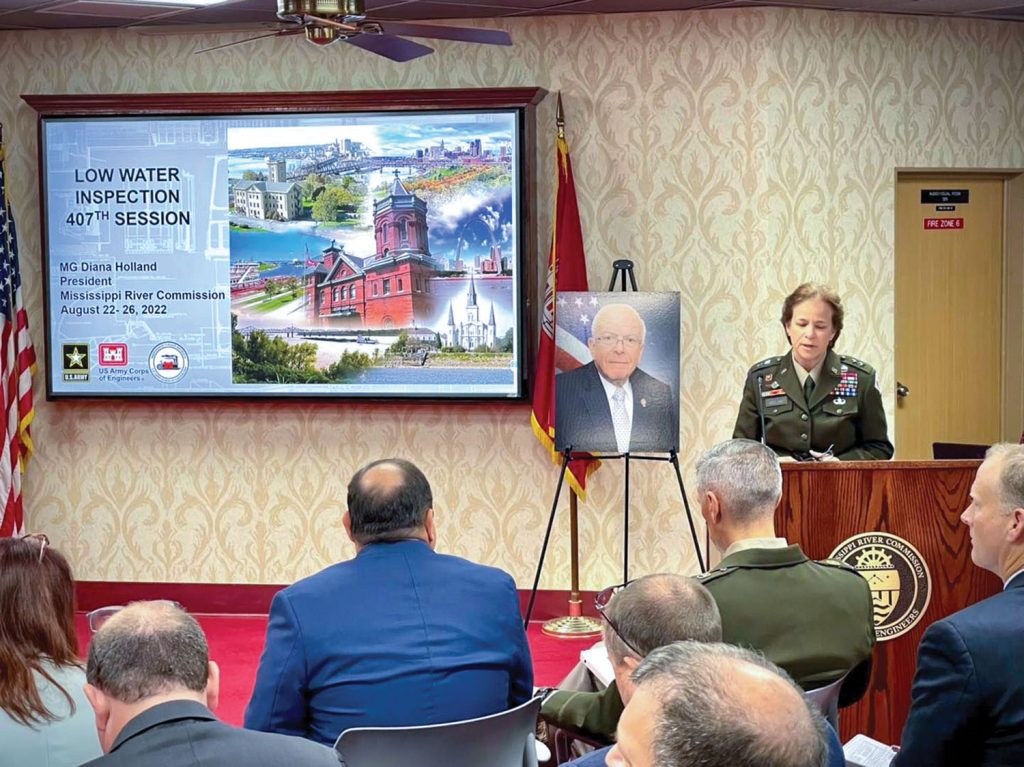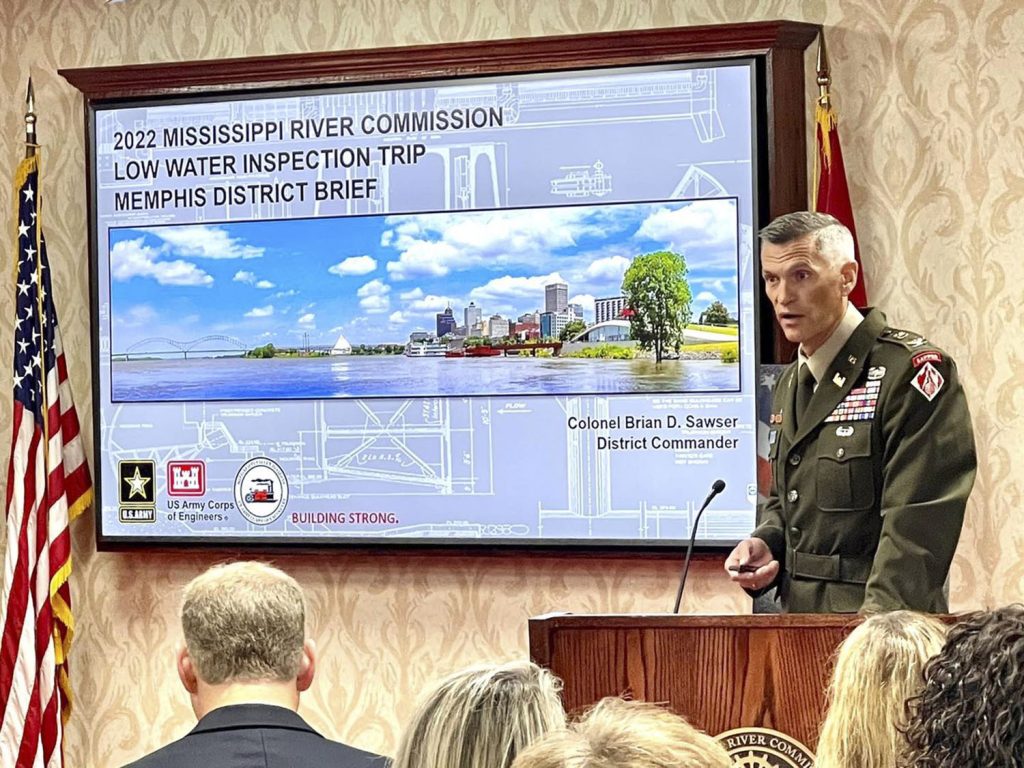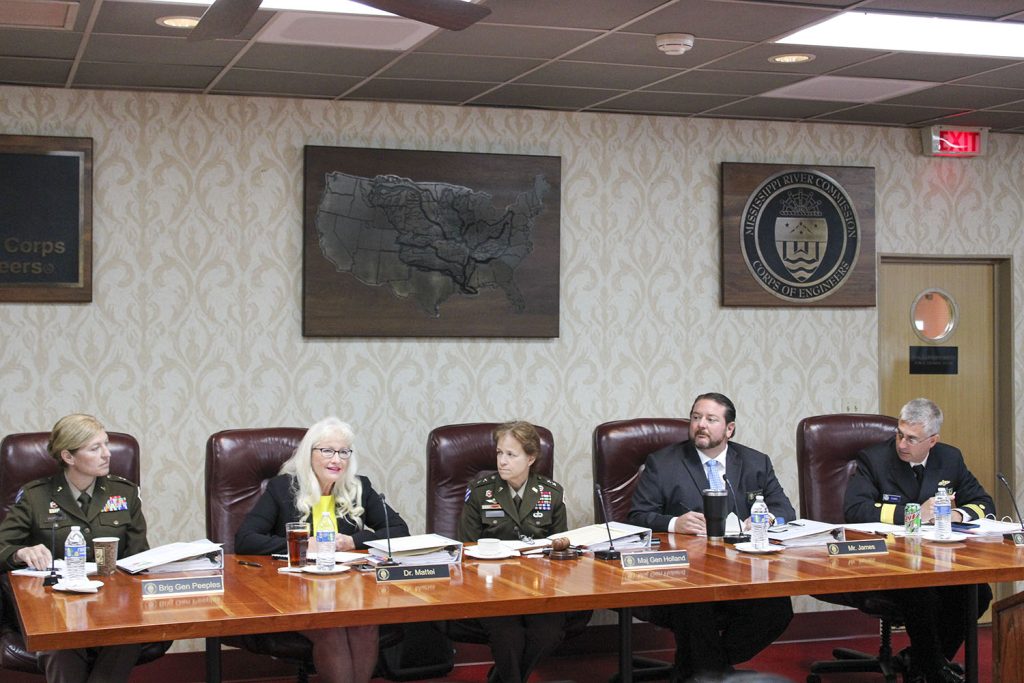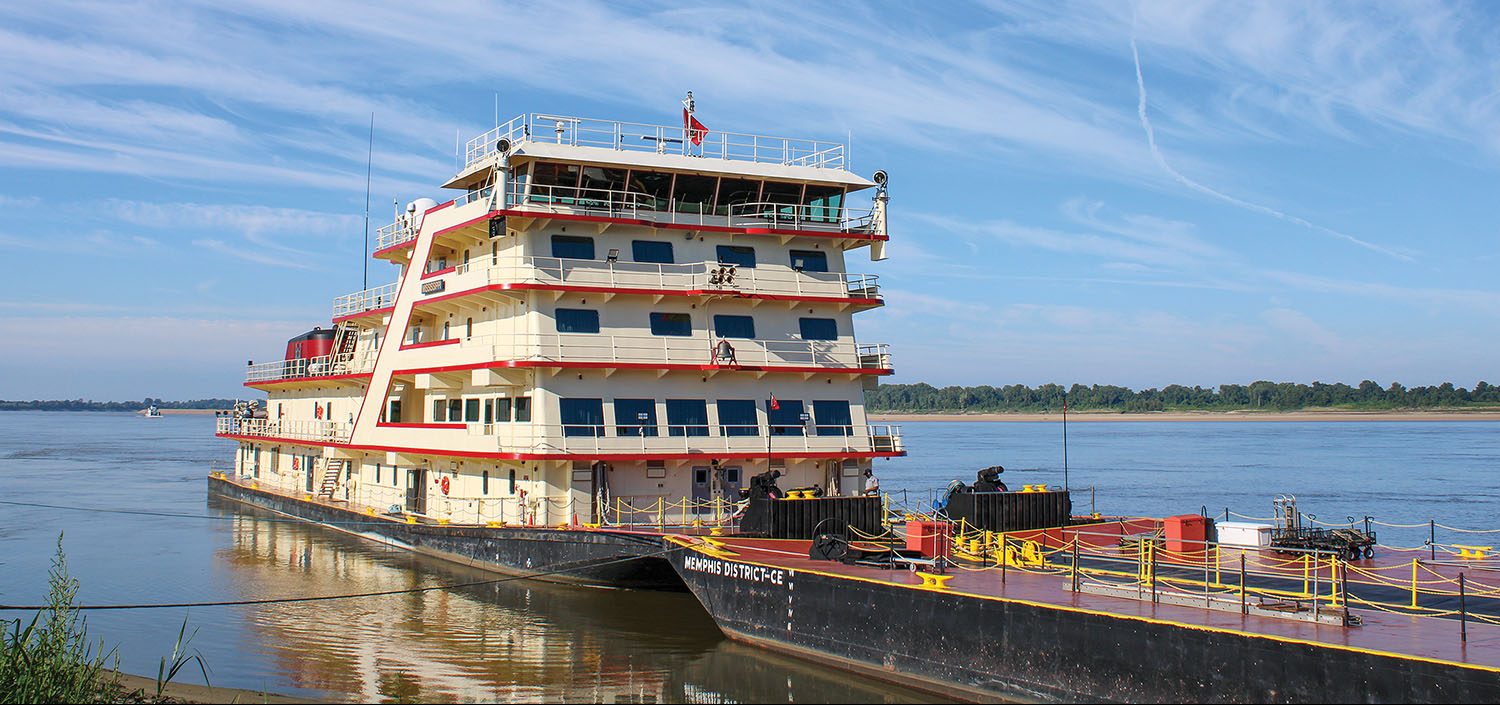The Mississippi River Commission gave updates on projects along the Mississippi River and heard testimony about local impacts while visiting four locations August 22–26 during its annual low-water inspection trip.
The meetings took place on the mv. Mississippi and were held in Tiptonville and Memphis in Tennessee; Vicksburg, Miss.; and Morgan City, La.
Each meeting included remarks from Maj. Gen. Diana Holland, commander of the Mississippi Valley Engineer Division, and an update from the commander of the local Corps district.Following their presentations, members of the public had an opportunity to present verbal and written testimony.
At the Tiptonville meeting August 22, this included roughly a dozen people who either thanked the commission for the progress or completion of projects or urged the commission for continued work in their localities. Most of the projects mentioned concerned levee maintenance or the importance of continued dredging.
About 50 people attended the meeting, including commanders of several engineer districts and elected office holders and their representatives.
Col. Andy Pannier, secretary of the Mississippi River Commission, welcomed participants to the William Clifford Smith hearing room, newly renamed for this year to honor the late Smith, a former commission member.

Commissioners also remembered former commissioner Sam E. Angel, who died earlier this month. Smith was the longest serving Mississippi River Commission member, serving for more than 40 years. Plaques with both men’s photos were prominently displayed during the meeting.
The Mississippi River Commission was established by Congress in 1879 to consider and mature plans to improve the Mississippi River, to promote and facilitate commerce and to prevent destructive floods, Pannier said. The commission makes recommendations for policies and work programs, studying and reporting on the necessity for modifications or additions to the Mississippi River & Tributaries (MR&T) flood control and navigation project.
The seven commission members, appointed by the president of the United States and confirmed by the Senate, include three U.S. Army Corps of Engineers officers, three civilian members, two of whom must be civil engineers, and one member from the National Oceanic and Atmospheric Administration. They are required to make inspection trips of the river each year, which they typically do during a high-water period in the spring and a low-water period in the late summer, and to hold public hearings during those trips. The most recent trip was part of the 407th session of the commission.
Historic Investment
In her opening remarks, Holland noted that the year has been marked by historic investment in the Corps’ Civil Works program and the Mississippi River and tributaries, including from the Infrastructure Investment and Jobs Act.
The Mississippi Valley Division alone has the responsibility for administering $7 billion in funding, she said.
“Our nation and our Congress know that the investment is important, that the upgrades we require are important, that modernization is important, that the changing dynamics of our river, the changing hydrology require changes in infrastructure, and they have invested in us,” Holland said.
That funding will be used for projects as far north as the St. Paul Engineer District all the way to the Gulf of Mexico in the south, she said.
“Of course, there are still things that need to be addressed, and that’s why we’re here today and why we look forward to your testimony,” Holland said.
Holland showed a slide of five project sites the commission visited on its April trip on the mv. Mississippi. They included an ADM grain elevator in New Orleans and a Marathon oil refinery that was nearby, the Delta Dirt Distillery in West Helena, Ark., a Big River Steel plant site near Osceola, Ark., and the ground-breaking for the floodwall in Caruthersville, Mo. Those projects show how the commission’s decisions affect agriculture and commerce, energy and jobs, businesses, manufacturing and industry and lives and communities, she said.
“Each of them illustrates how the river supports that particular business or industry and how it benefits from the MR&T project,” Holland said.
The MR&T project provides a return on investment of 117 to 1, she said.
Holland also briefly reported on a visit the commission made in July to its partner commission, the Lower Mekong River Commission, in Vietnam, Thailand, Laos and Cambodia. The U.S. State Department began the partnership between commissions in 2010 via the Sister Rivers Partnership to collaborate and share lessons learned. A few visits by one commission to the other’s region had been completed, and more were planned when they were delayed by the COVID-19 pandemic.
Holland said the most recent visit, which included a trip to Laos and Cambodia, was both fascinating and valuable.
“We learned that there is a lot of commonality, a lot of lessons that can be shared across those two river basins,” she said.
Next year, the Mekong commissioners will visit the Mississippi River Commission in the United States.
“We haven’t worked out the complete itinerary yet, but you will likely see them in this region,” Holland said.
She concluded her remarks by saying that it is an exciting time to live and work in the Mississippi Valley, to serve in the Corps of Engineers and to be a part of the Mississippi River Commission.

Funding Allocation
Col. Brian Sawser, Memphis District commander, used his time to speak about the status of projects throughout the Memphis district and their funding.
He noted that the district received $153.7 million in IIJA funding and $187.6 million in Disaster Relief Supplemental Appropriations Act (DRSAA) funding.
Of the funding received so far, $154 million has been obligated to more than 150 projects in all six states within the district. The district’s plan called for 46 construction projects to be completed by the end of September and 28 new contracts to be awarded. So far, 18 of the 28 contracts have been awarded with the other 10 on schedule, and 44 of the 46 projects will meet the construction completion deadline, he said.
“As a part of the overall division portfolio, within the Memphis District we’re also going to pick up and assist our partners down in New Orleans with the New Orleans to Venice project that’s occurring down South,” Sawser said.
With respect to river channel improvement, the Memphis district has more than 30 active projects, he said.
Sawser highlighted the Corps’ work on the $60 million rehabilitation of Tom Lee Park in Memphis, which will create a major new riverfront attraction for the city.
The Memphis district has also allocated IIJA funds to repair the boat ramp in New Madrid, Mo. That project should be awarded by the end of the calendar year and be in construction by next summer, Sawser said.

Twenty of the projects, costing $120 million, concern levee repair and maintenance. Earlier this year the Corps broke ground on the floodwall in Caruthersville, Mo. The district is also working on plans to replace the Helena, Ark., floodway and recently held a planning charette to begin planning a project to replace the floodwall in Cairo, Ill.
“All of these floodwalls, just in these three communities, have been in place for nearly 100 years, and we certainly look forward to their replacement,” Sawser said.
Additionally, he spoke about levee construction projects in Missouri, Arkansas and Kentucky.
“All three of these projects significantly reduce the threat associated with under-seepage,” he said.
Sawser also pointed out $120 million in work the Corps is continuing to deliver on the west side of the river, along the St. Francis River basin.
More Work Ahead
Commission members gave closing comments focusing on the importance of the work remaining for the commission.
Rear Adm. Benjamin K. Evans noted that “Water is life,” which is no less true on the Mississippi than it is on the Mekong.
Brig. Gen. Kimberly A. Peeples spoke about placing infrastructure that would stand the test of time.
Dr. Norma Jean Mattei, the senior commission member, said that with nearly 100 years of the MR&T Project behind the commission, the river continues to change, and so must the work of the commission, ensuring that needs are met for a safe and navigable waterway.
She said, “The fat lady will never sing for this project.”




